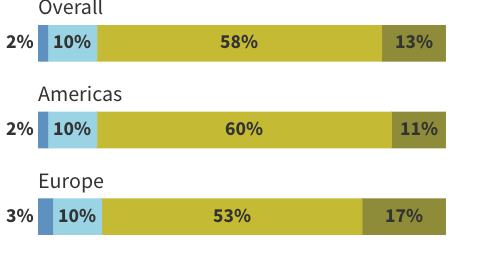As IT spending shifts to the cloud, ITAM must evolve. In this article, we explore insights for ITAM from key findings from the Tech Spend Pulse 2022 Flexera, where top priorities for technology initiatives continue to focus on digital transformation, cybersecurity and cloud/cloud migration. This shouldn't come as a surprise to any of us, as we've also seen these three priorities in 2021.
TOP 3 Priorities for technology initiatives
Flexera 2022 Tech Spend Pulse
Technology spending initiatives set the stage for ITAM's growing importance
of course the IT asset management (ITAM) is aware of the assets that make up the IT estate and are being digitized in this transformation, as well as the implications of adjusting to the ever-changing technology ecosystem – be it software licensing, application dependencies, or a host of other contextual elements. Desktops moving to laptops, moving from on-premises servers to cloud storage. Business value and growth are important factors that ITAM has the data points to influence.
This is why ITAM must get involved as soon as possible and will need to broaden the scope of what counts as an asset. Don't expect to be pulled in after the fact only to find that the licensing implications don't allow you to make changes effectively or, even worse, that they increase the cost to the organization in unexpected ways and contribute significantly to wasted spending for the business that falls on the ITAM group.
Digital transformation has changed asset management strategies, helping to open up opportunities
With the shift towards increased work-from-home policies due to the COVID-19 pandemic, we have seen IT asset management become more complex. For example, instead of having hardware asset management (HAM, eg device management) centralized in a few corporate locations or offices, there are now assets in thousands of separate, individual offices. How will ITAM keep up when these devices are not all on the corporate network at all times? How do you view, inventory and protect them?
How has the pace of digital transformation been impacted by the pandemic/recession?
Flexera 2022 Tech Spend Pulse
Another major digital shift has been the increased adoption of SaaS in response to the pandemic and changing IT ecosystem. More devices in more places with more software that can be purchased in a variety of ways. Adaptation is necessary for success in this changing environment, but the key is to do it strategically.
More budget, more people — How do you get what you need to do your job?
The vast majority of respondents Flexera's Tech Spend Pulse 2022 expected an increase (small or significant) in their IT budgets next year (64%). With this increase, the visibility within the organization of the ITAM function will also increase, as will the importance of tracking technology and limiting waste.
Percentage of respondents expecting a change in their IT budgets

Flexera 2022 Tech Spend Pulse
ITAM has traditionally been focused on reducing costs, so this is not surprising. But another way to look at it in a rapidly changing environment is through the lens of spending efficiency – getting the most out of your technology and maximizing your return on investment. If your company has increased its budget, this is the chance for ITAM to avoid duplication and overlap by highlighting through ITAM practices (eg application rationalization, license usage/consumption) where there are opportunities to optimize these technology investments.
This is also where ITAM's response to digital change is important; The withdrawal of investments such as data centers and on-premises software is expected at higher rates (budget reduction of 27% on each), while public cloud and SaaS investment is expected to continue to increase rapidly (59% and 69%, respectively). ITAM professionals have a role to play in this change and in its effective management.
Percentage with budget impacts to date due to COVID-19
Flexera 2022 Tech Spend Pulse
While the use of on-premises servers and storage, for example, is decreasing, they will likely never go away; there will likely always be a need for some degree of an on-site data center due to security, regulatory, intellectual property or other responsibilities. But the need for adaptation and expansion is critical.
By showing the company what you can do—that is, adapt to an ever-changing landscape—you are advocating that with more resources (FTEs, budget) you can better support the change the organization is going through. For example, as digital transformation continues to accelerate, most organizations (65%) still struggle to gain insight into their technology assets across the entire hybrid IT property, and even more lack the spend data to understand the impact (70%).
IT spend visibility challenges
Flexera 2022 Tech Spend Pulse
Seize the opportunity for ITAM to provide the data that fuels business strategy in a rapidly adapting organization. ITAM can provide traditional asset views from on-premises inventory, and more asset management teams are embracing SaaS in the hybrid environment, which allows them to align collaboration with their cloud counterparts (cloud center of excellence, FinOps, etc.). Talk to your stakeholders about how their investments and suppliers overlap. If you're one of the 65 percent without visibility, this is your chance to put that data in the hands of a single team – in this case, ITAM – that brings strategy to the table.
Strengthen your business case with top IT trends
As we head into 2023, we see the shift from on-premises software to SaaS, and from on-premises datacenters to the cloud, it continues to be the trend, but at the end of the day, people and services are the foundation of what makes IT run. the organization.
ITAM is clearly involved in all areas of IT – it’s in the acronym – but as the role spreads into new and evolving technology (and overlaps due to vendors like Microsoft delivering on-premises, SaaS and cloud ), the need to highlight its impact is even more important.
Reinforce your internal messages around headcount and budget, controlling your suppliers (spending efficiency), identify areas of opportunity by leveraging the data you have through a unified view of your assets, their dependencies and their effect on product delivery your business to customers. ITAM is key to maximizing technology investment, and adapting to these changes is key to successfully building your role for the future.
What ITAM?
IT Asset Management (ITAM) is “the set of business practices that embed IT assets across all business units of an organization. It brings together contractual, inventory, financial and risk management responsibilities to manage the entire lifecycle of these assets, including strategic decisions.” ITAM is often used in conjunction with IT Service Management (ITSM) and IT Operations Management (ITOM) to bring a holistic corporate approach.
IT Asset Management Software is a subsection of ITAM that generally encompasses both hardware and software. Companies can use ITAM software to visualize asset usage, helping them locate and remove any redundant hardware and software instances to reduce management costs.
Why is IT asset management software so important?
A company consists of different departments, each with its own set of IT assets. These assets are expensive and often require regular maintenance like license renewals, upgrades, etc. to maintain their value. With the right ITAM software, technicians will be able to monitor all hardware and software from a central location, reducing costs and increasing company productivity.
According to Gartner, “IT asset management provides an accurate account of technology asset lifecycle costs and risks to maximize the business value of technology strategy, architecture, financing, contracting, and procurement decisions.” it also includes a holistic approach that examines and simplifies the entire infrastructure, technology employed, finances, data procedures and business decisions.
What are the types of IT asset management?
Generally speaking, IT assets fall into one or more of the following categories: physical, software, hardware, mobile technology, and cloud. ITAM is designed to ensure successful deployment and ongoing support of IT assets. In this way, it matches these types of IT assets.
Following are the three main types of IT asset management:
- Software: This type of ITAM is a little more complex than other types of ITAM as it involves aspects such as compliance requirements, licensing, shadow IT and IoT. Software assets must be continuously monitored and reviewed, and the assets must be sufficiently liquid to meet requirements and meet ever-changing demands and markets.
- Hardware: Physical hardware also plays a role in an organization's IT sector. Among these assets we can mention computers, printers, copiers, notebooks, mobile devices, servers and any other hardware used for data management purposes in the company.
- Cloud: ITAM tracks the cost and usage of cloud resources, including SaaS (Software as a Service), IaaS (Infrastructure as a Service) and PaaS (Platform as a Service). All of them are considered as assets to be managed in terms of cost and compliance in ITAM.
ISO standards for ITAM
The International Organization for Standardization (ISO) has an official series of standards for ITAM: ISO 19770, which consists of five parts:
- ISO/IEC 19770-1: Describes best practices for enterprise ITAM. Organizations have the opportunity to demonstrate that they are implementing ITAM procedures in accordance with standards to meet governance requirements and support IT activities.
- ISO/IEC 19770-2: Helps companies identify software programs on a given device; a standard for software identification labels.
- ISO/IEC 19770-3: Method for specifying the allocation and measurement of consumption associated with software.
- ISO/IEC 19770-4: Allows the generation of standardized reports on resource usage. This is especially important when managing more complex licenses and cloud-based software and hardware.
- ISO/IEC 19770-5: An overview of ISO standards and vocabulary for ITAM.
ITAM processes
Track the entire lifecycle of IT assets
While individual organizations may define the lifecycle of IT assets differently, most follow steps similar to the following:
- Solicitation;
- Execution;
- Implantation;
- Monitoring;
- Service;
- deactivation.
In short, the cycle starts with identifying a need and placing an order. Important factors are defined, such as what assets are needed, how to acquire them, and how to use and finance them. During the execution phase, the creation, purchase, lease or licensing of assets takes place. Then comes the deployment phase, which oversees the installation of the asset into the IT ecosystem. Once deployed, the monitoring phase helps ensure the asset is operating effectively and entering the service phase, where the asset is maintained and upgraded to extend the asset's useful life. Finally, when these assets are no longer needed, they are deactivated and discarded. This includes moving users to alternate resources, updating records, canceling contracts, terminating licenses, and planning replacement assets.
When dealing with hardware, “inventory” can be included as a separate phase.
IT Asset Management Best Practices
- Start with executive membership;
- Start a team to pilot the project;
- Define essential assets;
- Identify cloud resources;
- Determine methods for data detection and integration;
- Use a lifecycle approach;
- Be proactive in your tracking initiatives and continually track them to avoid over-deployment;
- Decide if you want to use a CMDB;
- Automate as much as possible;
- Integrate and make data available to all of IT;
- Know your software licenses;
- Gather feedback for continuous improvement;
- Involve other teams in the feedback.
Should I implement ITAM in my organization?
There are several reasons why ITAM can help your organization thrive.
Economy
One of the main cost reduction strategies is to optimize spending on software, infrastructure and platform services. Organizations can reduce spend by up to 30% when they use best practices to optimize software licenses and asset usage.
Lack of visibility of the environment
Many corporations still track their assets using spreadsheets, but there is a high chance that their spreadsheets are not always accurate. In addition, spreadsheets can create data silos, making it difficult for all authorized users to access the same up-to-date information.
Difficulty keeping up with the pace of change
Assets are always on the move, and manual tracking may not be the best option. Dealing with issues like theft, replacement and decommissioning of IT assets, new shipments, etc. can create a chaotic IT environment that demands more attention to detail.
The reality of “shadow IT”
Shadow IT refers to applications, licenses and other IT assets that are being acquired and used without the knowledge of IT staff. Centralized ITAM software keeps IT on top of everything and prevents overspend, risk and non-compliance. Shadow IT is a reality that almost all modern companies face. How you manage it will make a difference in the level of control needed to reduce risk and expense.
References: The ITAM Review, As IT spending shifts to the cloud, ITAM must evolve; ServiceNow, what is ITAM; Manage Engine, What is IT Asset Management (ITAM) and how it can optimize the business.


